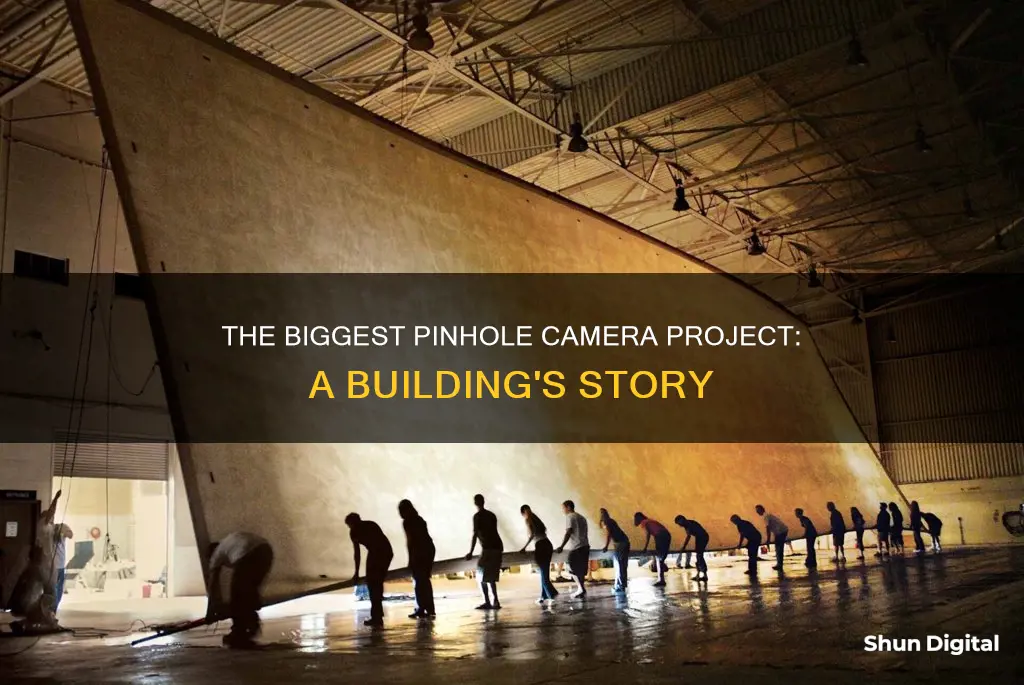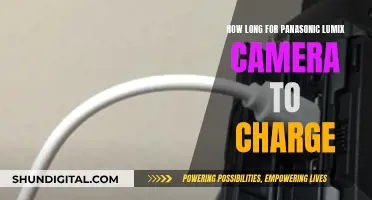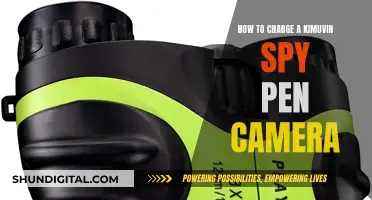
The world's largest pinhole camera was constructed inside an abandoned F-18 hangar at a former fighter base in Irvine, California. The hangar-turned-camera was used to capture a panoramic image of the former El Toro Marine Corps Air Station, which was in the process of being transformed into the Orange County Great Park. The photograph, titled 'The Great Picture', was created by six artists in 2006 and currently holds the Guinness World Record for the largest photograph made directly from a camera.
| Characteristics | Values |
|---|---|
| Name | The Great Picture |
| Date | 2006 |
| Location | F-18 hangar in Irvine, California |
| Purpose | To celebrate the hangar's location before it was transformed into a park |
| Dimensions | 111 feet high and 32 feet wide |
| Camera Dimensions | 160 ft wide x 45 ft high x 80 ft deep |
| Pinhole Diameter | 6 millimetres |
| Distance between pinhole and cloth | 80 feet |
| Exposure Time | 35 minutes |
What You'll Learn

The Great Picture
The photograph measures 111 feet (34 m) wide and 32 feet (9.8 m) high, with an area of 3,505.75 sq ft (325.695 m2). It depicts a black-and-white negative print of the Marine Corps Air Station with its control tower and runways, with the San Joaquin Hills in the background. The photograph was unveiled on July 12, 2006, during a reception held in the hangar and has been exhibited in various locations, including the Art Center College of Design in Pasadena, California, the Art Museum of the Central Academy of Fine Arts in Beijing, China, and the National Air and Space Museum of the Smithsonian Institution.
Disposing of Camera Batteries: A Safe Guide
You may want to see also

F-18 hangar
The world's largest pinhole camera was constructed in an F-18 hangar in Irvine, California. The hangar, measuring 160 ft wide, 45 ft high, and 80 ft deep, was once used to house F/A-18 Hornet fighter jets. The McDonnell Douglas F/A-18 Hornet is a twin-engine, supersonic, all-weather, carrier-capable, multirole combat aircraft, designed for the United States Navy and Marine Corps. With a top speed of Mach 1.8, these jets can perform a range of missions, including fighter escort, fleet air defence, and aerial reconnaissance.
The hangar, building #115 at El Toro, was transformed into a camera obscura, a light-tight box with a tiny aperture, by six photographer artists and around 400 assistants. The hangar's vast dimensions allowed for the creation of a panoramic photograph, titled "The Great Picture," measuring 111 ft wide and 32 ft high. This photograph, developed in 2006, holds the Guinness World Record for the largest print photograph.
The process of turning the hangar into a camera involved sealing the space to make it light-tight and creating a pinhole aperture. A seamless piece of muslin cloth, measuring 80 ft by 24 ft, was made light-sensitive and hung from the ceiling, positioned about 80 ft from the pinhole. This setup allowed for the projection of an inverted image of the scene outside the hangar, capturing a panoramic view of the former El Toro Marine Corps Air Station.
The F-18 hangar, thus repurposed, demonstrates the innovative use of space and technology to create a unique photographic experience, resulting in a world-record-breaking photograph.
Mastering Camera Modes: Switching for Better Shots
You may want to see also

Camera obscura
The largest pinhole camera ever made was constructed inside an abandoned F-18 hangar at a former Marine Corps Air Station in Irvine, California. The hangar was transformed into a light-tight camera obscura, measuring 160 ft wide by 45 ft high by 80 ft deep. The camera was created by six photographer artists, Jerry Burchfield, Mark Chamberlain, Jacques Garnier, Rob Johnson, Douglas McCulloh, and Clayton Spada, who were assisted by around 400 people. The camera obscura was used to take a panoramic photograph of the former air base, which was exhibited for the first time at the Art Center College of Design in Pasadena, California, in 2007.
The term "camera obscura" comes from the Latin "camera obscūra", meaning "dark chamber". It is a natural phenomenon where rays of light pass through a small hole into a dark space, forming an inverted and reversed projection of the view outside. This occurs, for example, when gaps between overlapping tree leaves create replica images of the sun on flat surfaces. The camera obscura effect has been known about for centuries, with early descriptions found in Chinese and Ancient Greek texts from around 500 BCE.
A camera obscura can refer to a natural occurrence of this phenomenon or to a constructed space, such as a darkened room, box, or tent, in which an exterior image is projected inside. The use of a lens in the opening of a camera obscura has been common since the 16th century, and camera obscuras became popular as drawing and painting aids. The addition of a lens allows for a larger aperture, resulting in a brighter image while maintaining focus.
The use of camera obscuras as drawing aids was further developed in the 17th century, with the device becoming portable and sometimes taking the form of a small tent or box. This technology was later adapted to create the photographic camera in the first half of the 19th century. The basic principle of the camera obscura, where an image is projected through a pinhole or small aperture, remains central to photography today.
The Evolution of the UDSC15 Camera: Still in Production?
You may want to see also

Pinhole photography
The first known description of pinhole photography was by Scottish inventor David Brewster in his 1856 book, "The Stereoscope". He described it as "a camera without lenses, and with only a pin-hole". However, the technique became more established in photography during the late 19th century, appreciated for the soft outlines it produced compared to the sharp images of lenses.
The world's largest pinhole camera was created in 2006 by six photographer artists: Jerry Burchfield, Mark Chamberlain, Jacques Garnier, Rob Johnson, Douglas McCulloh, and Clayton Spada. They transformed an abandoned F-18 hangar (#115) at the former Marine Corps Air Station El Toro in Irvine, California, into a giant pinhole camera. The hangar-turned-camera measured 160 ft wide, 45 ft high, and 80 ft deep. The final photograph, titled "The Great Picture," measured 111 ft wide and 32 ft high, earning it the Guinness World Record for the largest photograph made directly from a camera.
Exiting Camera Mode: Quick and Easy Steps
You may want to see also

History of pinhole cameras
The pinhole camera, also known as the camera obscura or "dark chamber", is a simple imaging device in the shape of a closed box with a tiny hole on one side. The earliest surviving description of this kind of observation is from the 5th century BCE, written by Chinese philosopher Mo Ti. In the Western world, Aristotle, in the 4th century BCE, observed that sunlight passing through quadrilaterals, such as the holes in wickerwork, created a round image. He also observed that the image of a solar eclipse passing through a sieve, tree leaves, or the gaps between crossed fingers created a crescent on the ground.
In the 10th century CE, the Arabian physicist and mathematician Alhazen (Ibn al-Haytham) studied the reverse image formed by a tiny hole and indicated the rectilinear propagation of light. He is also credited with inventing the camera obscura, the precursor to the pinhole camera, to demonstrate how light can be used to project an image. In the 13th and 14th centuries, different scientists used the pinhole principle to study the eclipse of the sun and the wavelength of light. In the 15th century, the technique was used by artists as an aid for their drawings.
The first picture of a pinhole camera obscura is a drawing by Gemma Frisius, an astronomer, in his book De radio astronomico et geometrico liber, published in 1545. He used the pinhole in his darkened room to study the solar eclipse of 1544. Leonardo da Vinci gave a clear description of the camera obscura in the 16th century, describing how one could get an image on a transparent screen and trace it. In the 18th century, the camera obscura became generally known, and travellers started using portable versions to trace the things they saw during their journeys. These "snap-shots" were pasted into their travel books and kept as souvenirs.
The first photograph taken with a pinhole camera was by Scottish scientist Sir David Brewster in 1850, but the technique became more established in photography during the late 19th century, noted for the soft outlines it produced. The pinhole camera was later abandoned until the end of the 1960s when several artists began using it in their experiments, thus awakening renewed interest in this simple photographic apparatus.
GoPro 6 Black: Charging and Camera Functionality
You may want to see also
Frequently asked questions
The largest pinhole camera ever made was called 'The Great Picture'. It was 160 ft (48.76 m) wide, 45 ft (13.71 m) high, and 80 ft (24.38 m) deep.
The Great Picture was made from 24,000 square feet (2,200 m2) six mil black visqueen, 1,300 US gallons (4,900 L) of foam gap filler, 1.5 miles (2.4 km) of 2-inch (5.1 cm) wide black Gorilla Tape, and 40 US gallons (150 L) of black spray paint.
The Great Picture was located in an abandoned F-18 hangar at a closed fighter base in Irvine, California.
The photograph, also called 'The Great Picture', was a panoramic black-and-white negative print of the Marine Corps Air Station El Toro, with its control tower and runways, and the San Joaquin Hills in the background.







